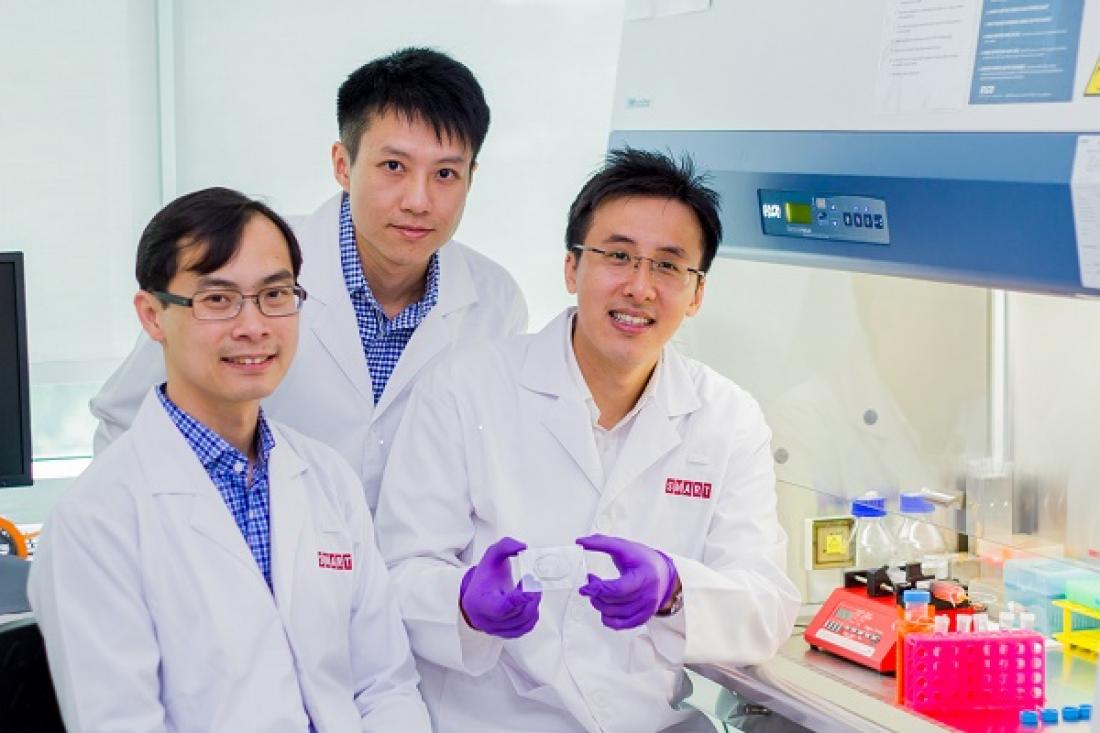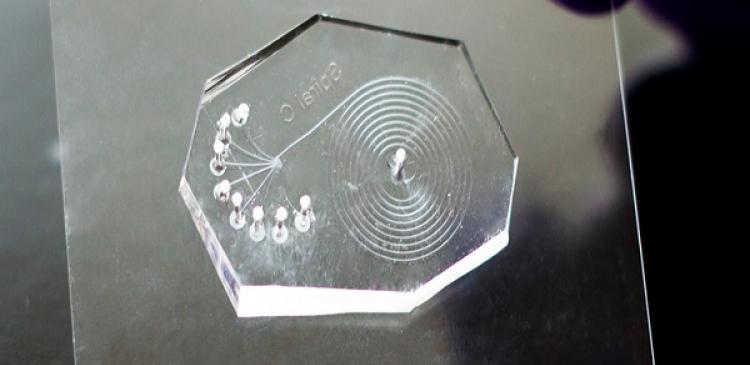(L-R) Associate Professor Jerry Chan, SMART co-Investigator; Dr Zhiyong Poon, SMART Research Scientist and Dr Jacky Lee, former SMART Postdoctoral Associate, with the microfluidics cell sorting device that isolates Mesenchymal Stem Cells (MSCs) for bone and muscle therapeutic applications. This device can reduce the analysis and decision-making process from 1 - 2 months to less than 3 days.
A team of scientists and engineers at the Singapore-MIT Alliance for Research and Technology (SMART) [新加坡-麻省理工学院科研中心] have invented a new technique to identify populations of rare stem cells from bone marrow based on their different combinations of biophysical characteristics such as cell size, cell stiffness and nucleus deformation.
Mesenchymal stem cells (MSCs), a type of cells which resides in the bone marrow, can differentiate into cells that produce bone, cartilage, fat or muscles – a trait that clinicians exploit for tissue repair. (See Factsheet)
With better identification of MSCs, doctors can be certain that the concentration of highly enriched MSC mixture is as stated, making it easier for them to develop stem- cell-based treatment that would be more consistent and produce better results.
Currently, there is no good way to separate MSCs from bone marrow cells that have already begun to differentiate into other cell types, but share the same molecules on the cell surface. This may be one reason why research results vary among laboratories and why stem-cell treatments now in clinical trials are not as effective as they could be, explained Krystyn Van Vliet, Lead Investigator, SMART BioSystems and Micromechanics (BioSyM) Interdisciplinary Research Group (IRG).
The research entitled ‘Multivariate biophysical markers predictive of mesenchymal stromal cell multipotency’ will be published in the prestigious scientific journal Proceedings of the National Academy of Sciences this week. Lead authors of the paper are Dr Jacky Lee and Dr Hui Shi, a former SMART Postdoctoral Associate.
Dr Jacky Lee [李旺城] carried out this work over five years as a graduate student and later as a Postdoctoral Associate in SMART BioSyM under the supervision of:
• Prof Van Vliet;
• Prof Jongyoon Han, SMART Principal Investigator; and
• SMART Singapore co-Investigator and main PhD supervisor, Prof Lim Chwee Teck from National University of Singapore (NUS).
Other authors include SMART co-Investigators - Associate Professor Jerry Chan from KK Women’s and Children’s Hospital (KKH) and G. Shivashankar from NUS; SMART Research Scientist Dr Zhiyong Poon; and SMART researchers L.M Nyan and T. Kaushik.
Dr Jacky Lee said, “Currently, researchers try to isolate MSCs based on protein markers found on the cell surfaces. But these markers lack sufficient ‘resolution’ to distinguish between subpopulations of MSC with distinct functions. This approach to identify subpopulations of stem cells, distinct from other marrow stromal cells, has re-ignited hope for better stem-cell treatments.”
SMART Research Scientist Dr Zhiyong Poon [潘志勇], said: “We are in the process of starting clinical trials on the use of biophysically sorted cells for bone marrow regeneration and repair.”
Associate Professor Jerry Chan [陈国贤副教授], who is also Director, KK Research Centre and Senior Consultant, Department of Reproductive Medicine at KKH [竹脚妇 幼医院研究中心主席兼生育医药部门资深顾问医生], said, “This important discovery will allow us to identify and select the best population of stem cells that we can use for treating different diseases such as brittle-bone disease or in repairing large bone defects. We anticipate that this technique will enhance our knowledge of the cells being used in our upcoming clinical trial to repair large bone defects.”
BETTER REGENERATION
The researchers tested injected MSCs in mice and found that these cells could repair both muscle and bone injuries, while marrow-derived cells identified as osteogenic stromal cells were able to repair bone but not muscle.
Dr Hui Shi said, “Our test in mice showed that MSCs can be identified and highly enriched for bone growth and muscle repair. This means that we can select, purify
and concentrate MSCs for tissue repair for people who, for instance, suffer from knee joint pain.”
Going forward, the SMART team hopes to develop high-speed methods for separating MSC subpopulations. This research is funded by the Singapore National Research Foundation, Prime Minister’s Office, under its Campus for Research Excellence And Technological Enterprise (CREATE) programme.
*** END ***
Media contact:
Pauline Teo
Corporate Communications Specialist
SMART
Tel: 6601 3354 HP: 9748 5012
Email: [email protected]
************************************************************************************************
About SMART
The SMART Centre is a major research enterprise established by the Massachusetts Institute of Technology (MIT) in partnership with the National Research Foundation of Singapore (NRF) since 2007. It is the first entity in the Campus for Research Excellence and Technological Enterprise (CREATE) developed by NRF.
The SMART Centre serves as an intellectual hub for research interactions between MIT and Singapore. Cutting-edge research projects in areas of interest to both Singapore and MIT are undertaken at the SMART Centre. SMART comprises an Innovation Centre and five Interdisciplinary Research Groups (IRGs): BioSystems and Micromechanics (BioSyM), Center for Environmental Sensing and Modeling (CENSAM), Infectious Diseases (ID), Future Urban Mobility (FM) and Low Energy Electronic Systems (LEES).
About SMART BioSyM IRG
BioSystems and Micromechanics (BioSyM) Inter-Disciplinary Research Group brings together a multidisciplinary team of faculties and researchers from MIT and the Universities and Research Institutes of Singapore. BioSyM’s research deals with the development of new technologies to address critical medical and biological questions applicable to a variety of diseases with an aim to provide novel solutions to the healthcare industry and to the broader research infrastructure in Singapore. The guiding tenet of BioSyM is that accelerated progress in biology and medicine will critically depend upon the development of modern analytical methods and tools that provide a deep understanding of the interactions between mechanics and biology at multiple length scales – from molecules to cells to tissues – that impact maintenance or disruption of human health.
*******************************************************************************************
FACTSHEET
About Stem Cells
• Immature cells that have genetic material that moves around inside the nucleus, producing more fluctuations of the nuclear cell membrane.
• Have less rigid cytoskeletal structure than those of highly differentiated cells, at least when adhered to materials such as glass, making those attached cells seem less stiff.
About Mesenchymal Stem Cells (MSCs)
• Immature cells that can differentiate into cells that produce bone, cartilage, fat or muscle
• Resides deep within the bone marrow
• Make up only a small percentage of cells in the bone marrow
About Osteogenic Stromal Cells
• Resides deep within the bone marrow together with MSCs
• Have already begun the developmental path towards becoming cartilage or bone-producing cells
About Stem-cell treatments (bone, muscle, cartilage)
• MSCs are currently being investigated for a range of clinical applications such as bone repair, vascular insufficiency, cardiac failure, graft-versus-host disease, diabetes and others.




